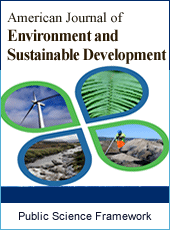American Journal of Environment and Sustainable Development
Articles Information
American Journal of Environment and Sustainable Development, Vol.5, No.2, Jun. 2020, Pub. Date: Jun. 29, 2020
Impact of Irrigation Projects on Rural Community Livelihoods in Rwanda
Pages: 30-36 Views: 2027 Downloads: 835
[01]
Narcisse Hakizimana, Faculty of Environmental Studies, University of Lay Adventists of Kigali (UNILAK), Kigali, Rwanda.
[02]
Olive Nishimwe, Faculty of Environmental Studies, University of Lay Adventists of Kigali (UNILAK), Kigali, Rwanda.
[03]
Lamek Nahayo, Faculty of Environmental Studies, University of Lay Adventists of Kigali (UNILAK), Kigali, Rwanda.
[04]
Abias Maniragaba, Faculty of Environmental Studies, University of Lay Adventists of Kigali (UNILAK), Kigali, Rwanda.
In Rwanda, about 80% of population works in subsistence agriculture. This study aimed to analyze the extent to which irrigation project contributed to its beneficiaries’ livelihoods in Rwamagana district of Rwanda. A purposive or judgmental sampling strategy selected a sample size of 208 people living around and working with the project. The questionnaire was used to collect data which were analyzed by using the Statistical Package for Social Sciences (SPSS) along with Microsoft Excel. The results indicated that 71.6 percent of respondents were male and 70.2 percent were aged between 16 and 30 years old. It was noted that 95.7% of project beneficiaries were single individuals not members of cooperatives growing rice in the irrigation sites under construction. For livelihoods improvement, it was noted that some of informants bought land (16.8%), livestock (39.9%), houses (1.9%), and bicycles (11.1%). The informants indicated that future project management to sustainably contribute to community livelihoods, should base on the protection of irrigation structures (75%), and efficiency use of irrigation water (25%). The analysis suggests government and stakeholders to ensure that local farmers affected by the project are given priority during employment process. This would help them to cover the loss from stopping their agricultural activities where irrigation project is taking place. In addition, delivering training to rice farmer’s cooperative about dam maintenance and protection of concrete irrigation structures would sustainably increase agricultural produce and rural livelihoods improvements as well.
Irrigation Project, Rural Community, Livelihoods, Rwamagana, Rwanda
[01]
Smith, L. E. (2004). "Assessment of the contribution of irrigation to poverty reduction and sustainable livelihoods." International journal of water resources development 20 (2): 243-257.
[02]
Mwabu, G. and E. Thorbecke (2004). "Rural development, growth and poverty in Africa." Journal of African Economies 13 (suppl_1): i16-i65.
[03]
Kadigi, R. M., G. Tesfay, et al. (2012). "Irrigation and water use efficiency in Sub-Saharan Africa." Policy Research Paper 4.
[04]
WORLD BANK (2013). Agricultural Development in Rwanda. [On line]. Available at World Wide Web: , retrieved on the 6th March2020.
[05]
Nahayo, L., L. Li, et al. (2016). "Agricultural impact on environment and counter measures in Rwanda." African Journal of Agricultural Research 11 (25): 2205-2212.
[06]
MINAGRI, (2018). Strategic Plan for Agriculture Transformation 2018-24.
[07]
MINAGRI, RAB and JICA (2016). Resettlement Action Plan (RAP) for the Proposed Project of Rehabilitation of Irrigation Facilities in Rwamagana district, Republic of Rwanda. Final report.
[08]
MINAGRI (2017). Sustainable Agricultural Intensification for Improved Livelihoods, Food Security and Nutrition Project (SAIP)
[09]
FAO, (2017). Water for Sustainable Food and Agriculture. A report produced for the G20 Presidency of Germany.
[10]
Noemi M., Richard L. Snyder et al. (2017). Water Scarcity and Future Challenges for Food Production.
[11]
KTPRESS, (2018). Muyanza Water Dam: Rwanda Creates A New Agricultural Wonder. [On line]. Available at World Wide Web: , retrieved on the 26th February 2020.
[12]
Xinhua net,(2018). Chinese-built second highest dam in Rwanda to benefit farming sector: official. [On line]. Available at World Wide Web: , retrieved on the 26th February 2020.
[13]
Narayanan, K. (2014). "Impact of participatory irrigation management–case study: Cocurirwa Cooperative, Rwamagana Rice Project, Rwanda." Advances in Plants & Agriculture Research 1 (3): 00013.
[14]
JICA (2017). The Preparatory Survey on the Project for Rehabilitation of Irrigation Facilities in Rwamagana district, in the Republic of Rwanda. Final report. February, 2017.
[15]
National Institute of Statistics of Rwanda (NISR), Ministry of Finance and Economic Planning (MINECOFIN) [Rwanda]; 2012. Rwanda Fourth Population and Housing Census.
[16]
Rwamagana district Website, visited on the 10th March2020.
[17]
Twagirimana Jean Claude (2014). The impact of water shortage to human development. A case study of Kigali City. UNILAK. Master of Business Administration, Option of Project Management, 2014.
[18]
MAXWELL, J. A. (1996). Qualitative Research Design: An Interactive Approach London, Applied Social Research Methods Series.
[19]
Taherdoost, H. (2016). "Sampling methods in research methodology; how to choose a sampling technique for research." How to Choose a Sampling Technique for Research (April 10, 2016).

ISSN Print: Pending
ISSN Online: Pending
Current Issue:
Vol. 6, Issue 4, December Submit a Manuscript Join Editorial Board Join Reviewer Team
ISSN Online: Pending
Current Issue:
Vol. 6, Issue 4, December Submit a Manuscript Join Editorial Board Join Reviewer Team
| About This Journal |
| All Issues |
| Open Access |
| Indexing |
| Payment Information |
| Author Guidelines |
| Review Process |
| Publication Ethics |
| Editorial Board |
| Peer Reviewers |


